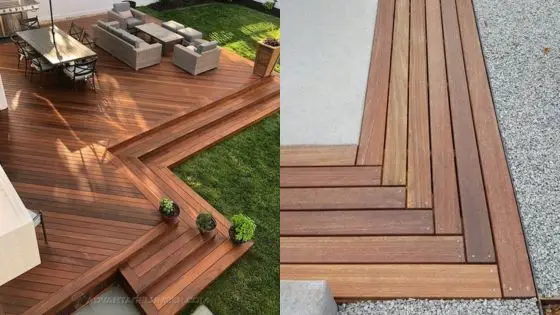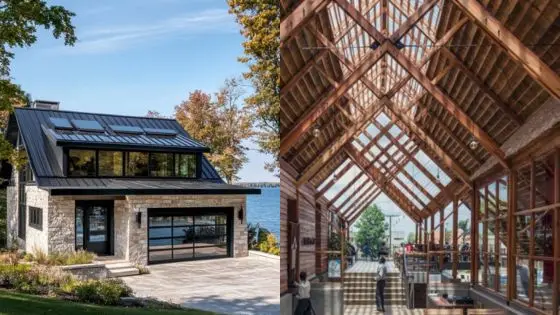Creating an outdoor bar transforms an ordinary backyard into an inviting entertainment space where friends and family can gather year-round. A well-designed outdoor bar combines functionality and style, featuring weather-resistant materials, proper storage, and essential amenities like refrigeration and seating to enhance the outdoor living experience.
Building an outdoor bar requires careful planning to ensure it withstands various weather conditions while maintaining its aesthetic appeal. The right location, materials, and layout make a significant difference in both usability and longevity.
Professional installation of an outdoor bar typically ranges from $3,000 to $15,000, depending on size, materials, and features. DIY options can reduce costs significantly while allowing for customization to match specific space requirements and design preferences.


Key Takeaways
- A properly designed outdoor bar enhances property value and creates a dedicated entertainment space
- Weather-resistant materials and strategic placement ensure longevity and year-round functionality
- Professional installation offers reliability while DIY approaches provide cost savings and customization options
Designing Your Outdoor Bar
A well-designed outdoor bar combines style, functionality, and weather-resistant features to create an inviting entertainment space. The right materials and thoughtful planning ensure your bar will stand up to the elements while maintaining its aesthetic appeal.
Choosing a Theme and Style
Select a style that complements your home’s exterior architecture and landscaping. Modern designs feature clean lines, metal finishes, and minimalist seating, while rustic bars incorporate natural wood and stone elements.
Consider these popular outdoor bar themes:
- Tropical tiki bar with bamboo accents
- Mediterranean villa with terracotta tiles
- Industrial modern with concrete and steel
- Classic poolside cabana style
The bar layout should include adequate seating space and a dedicated prep area. A standard bar height of 42 inches works well for both standing and seated guests.
Selecting Durable Materials
Choose materials rated for outdoor use to prevent damage from sun, rain, and temperature changes. Marine-grade stainless steel resists rust and corrosion, making it ideal for countertops and appliances.
Best materials for outdoor bars:
- Weather-resistant woods like teak or cedar
- Powder-coated aluminum frames
- Composite decking materials
- Natural stone or concrete countertops
Waterproof storage cabinets protect glasses, mixers, and bar tools from moisture and dust.
Planning for Outdoor Conditions
Install proper drainage systems to prevent water pooling on countertops and flooring. Strategic placement of overhead structures provides shade and rain protection.
Built-in lighting enhances visibility and ambiance after sunset. Consider:
- LED strip lighting under counters
- Solar-powered accent lights
- Weather-resistant pendant fixtures


Essential Features and Accessories
A well-designed outdoor bar combines functionality with comfort to create an inviting entertainment space.
Ensure that you have some kind of shelter. For example, you could get an established awning contractor like Uni Shades to install an awning or a roof.
The right mix of features transforms a basic patio into a complete outdoor entertainment destination.
Incorporating a Fire Pit
Fire pits serve as natural gathering spots and extend outdoor entertaining into cooler evenings. A gas-powered fire pit offers convenience with instant flames and temperature control.
Wood-burning fire pits create an authentic ambiance with crackling sounds and smoky aromas. Select a pit size that accommodates 4-6 people comfortably.
Consider a fire pit table combination for versatility. These units provide warmth while doubling as functional table space for drinks and snacks.
Safety features like spark screens and weather covers are essential accessories. Place the fire pit at least 10 feet from structures and seating areas.
Setting Up a Bar Cart
A mobile bar cart provides flexibility to serve drinks wherever needed. Choose weather-resistant materials like powder-coated aluminum or teak for durability.
Essential bar cart features include:
- Multiple shelves for storage
- Wine bottle holders
- Stemware racks
- Locking wheels
- Ice bucket compartment
Stock the cart with plastic drinkware, bottle openers, and basic mixology tools. Add LED lighting for evening visibility.
Adding Lounge Seating
Weather-resistant sofas and chairs with quick-dry cushions create comfortable conversation areas. Deep seating with 6-8 inches of cushioning provides optimal comfort.
Arrange furniture in small groupings to encourage conversation. Include side tables within arm’s reach of each seat for drink placement.
Mix seating types with:
- Built-in bench seating
- Swivel chairs
- Love seats
- Ottoman footrests
Integrating an Outdoor Kitchen
An outdoor kitchen expands entertaining capabilities beyond basic grilling. Install countertops at standard 36-inch height for comfortable food prep.
Essential outdoor kitchen components include:
- Stainless steel grill (minimum 30-inch width)
- Refrigerator for beverages
- Storage drawers
- Sink with running water
- Task lighting
Add outlets for small appliances and an outdoor TV mount for entertainment. Use marine-grade stainless steel for all appliances and hardware.
Consider a pergola or roof structure to protect the kitchen area from weather. Install ventilation if the space is partially enclosed.


Outdoor Bar Types and Ideas
An outdoor bar transforms any backyard into an entertainment hub. The right design and features create a functional space for hosting gatherings while adding value to your property.
Building a DIY Outdoor Bar
A DIY outdoor bar project starts with selecting weather-resistant materials like cedar, teak, or pressure-treated lumber. The basic structure requires a frame, countertop, and storage shelves.
Standard dimensions include a 42-inch bar height and 24-inch counter depth. Adding a roof or awning protects the bar and guests from weather elements.
Include essential features like a bottle rail, built-in cooler, and storage cabinets. LED lighting under the counter edge creates ambiance for evening gatherings.
Creating a Modern Outdoor Bar
Modern outdoor bars feature clean lines and minimalist designs with materials like stainless steel, concrete, and tempered glass. Integrated lighting systems highlight architectural elements.
Built-in refrigeration units and ice makers enhance functionality. Consider adding a prep sink with running water for convenience.
Smart features like Bluetooth speakers and USB charging stations add contemporary appeal. Weather-resistant outdoor bar stools with sleek designs complete the modern aesthetic.
Installing a Pergola
Pergolas provide shade and structure while defining the bar area. Cedar or aluminum pergolas offer durability and style options.
Install string lights or pendant fixtures between pergola beams for evening illumination. Retractable shade canopies offer versatile sun protection.
Add climbing plants like wisteria or grape vines for natural shade. The pergola posts can incorporate built-in storage or serving stations.
Adapting a Standup Bar
Standup bars maximize space with a vertical design. Install fold-down countertops for flexible serving areas that can be tucked away when not in use.
Built-in wine glass racks and bottle storage keep essentials organized. Add a small prep surface for mixing drinks and serving snacks.
Weather-resistant curtains create privacy and protection from wind. Mount televisions or projector screens for outdoor entertainment options.


Cost Considerations and Maintenance
Building and maintaining an outdoor bar requires careful financial planning and regular upkeep to preserve its functionality and appearance.
Estimating the Price of an Outdoor Bar
Basic outdoor bars start at $500 for DIY projects using simple materials like pressure-treated lumber and a concrete countertop. Mid-range options with quality hardwoods and stone surfaces typically cost $2,000 to $5,000.
High-end custom builds with premium materials, built-in refrigeration, and plumbing can range from $8,000 to $15,000 or more.
Key cost factors include:
- Material choices (wood, stone, stainless steel)
- Size and complexity of design
- Built-in appliances
- Professional installation
- Local permits and regulations
Maintaining Your Backyard Watering Hole
Regular cleaning of countertops and surfaces with appropriate cleaners prevents staining and bacterial growth. Wood components need annual sealing or staining to protect against weather damage.
Check plumbing connections and appliances every spring for leaks or damage. Clear drainage systems monthly during peak usage seasons.
Essential maintenance tasks:
- Daily wipedown of surfaces
- Weekly deep cleaning of tap lines
- Monthly inspection of electrical components
- Seasonal weatherproofing
- Prompt repair of any damage
Store removable components indoors during harsh weather. Cover fixed elements with waterproof materials rated for outdoor use.
- 0shares
- Facebook0
- Pinterest0
- Twitter0


